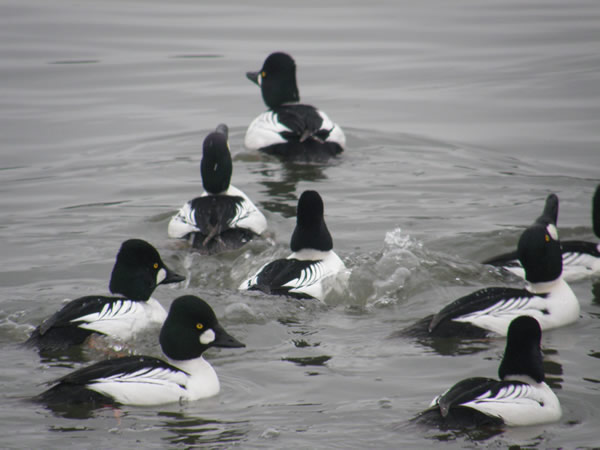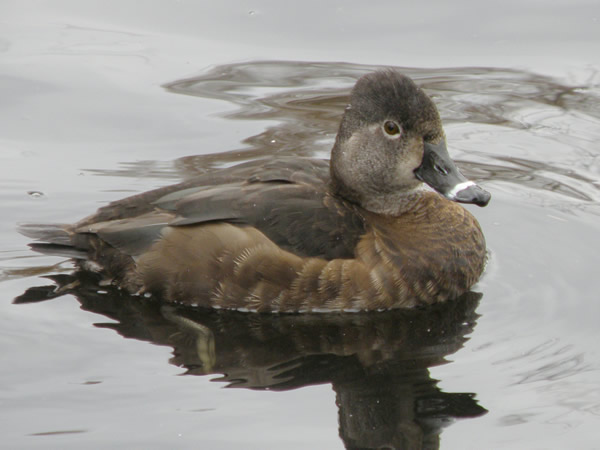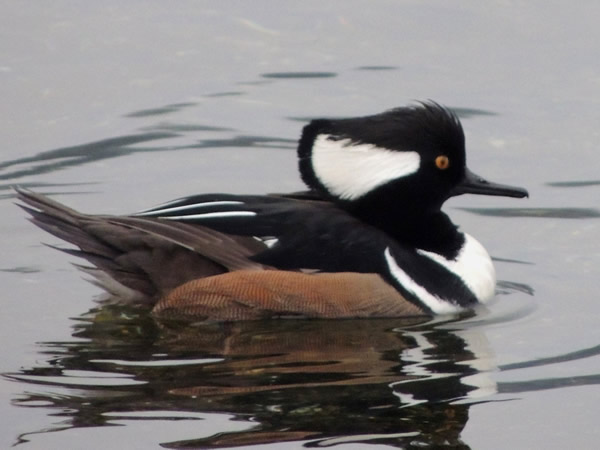|
Many ducks are referred to as diving ducks because, quite simply, they dive into the water in search of food. These divers include these Lesser Scaups, Goldeneyes, Buffleheads, Canvasbacks, mergansers and Ring-necked Ducks. |
| |
|
A male Bufflehead, Bucephala albeola, looks down in preparation for diving. The bodies of diving ducks are heavier than the dabblers which enables them to submerge quickly. |
| | |
 |
A male Common Goldeneye, Bucephala clangula, shows the technique required to dive. The legs are placed well back on the body so that the duck can dive effectively through the water. However this does not allow them to walk as well on land as dabbling ducks. |
| | |
 |
Under water after diving down, this Common Goldeneye uses its legs to swim smoothly through the water. Its short wings are used like a rudder for steering in different directions.
The wings of diving ducks are smaller in proportion to their size and have a much faster wing beat than the dabbling ducks. With smaller wings they are unable to take off vertically and have to run rapidly across the water before taking to the air. |
| |
|
Like most ducks, the males often have unusual plumage, colours and markings. Here a male Bufflehead swims by with the distinctive white spot on the back of his head which has stunning sheens of purple and green. |
| |
|
The female Bufflehead bares little resemblance to the male.
Her colourings, however, are ideal for camouflage when nesting. |
| |
|
The Bufflehead was named because of its short neck and head that is puffed out to about twice its true size. It was originally called Buffalo Head because of this characteristic. Here a male is contemplating a short diving excursion. |
| |
|
The male Common Goldeneye, Bucephala clangula, has an unusual white spot beneath its golden-yellow eye. |
| |
|
The female Common Goldeneye has plainer brown colours and no white facial markings but she does have the distinctive eye which gives these ducks their common name. |
| | |
|
Ducks have special adaptations which allow them to filter water out of the side of their bills, while keeping food in. The male Common Goldeneye on the left is seen filtering for food after a dive. |
| |
|
Common Goldeneyes enjoy their own company and often gather together in great numbers creating a very pretty and busy sight. |
| | |
 |
The Canvasback, Aythya valisineria, is named after its white back (which is more of a grayish colour in the female, shown here.) Another noticeable feature is its large, sloping bill. They like to dive deeply (up to 9 m/3 yds), so prefer the more remote, deeper parts of wetlands. This is also one of the fastest flying ducks.
Canvasbacks breed in the prairie wetlands, building their nests in marshes and lining them with down. They migrate and over-winter on the west coast in saltwater bays. |
| |
|
One of the most common and numerous diving ducks is the Lesser Scaup, Aythya affinis. The males are noted for being dark at each end and light in the middle. |
| |
|
The female Lesser Scaup is basically brown with a white patch at the base of the bill.
These birds dive for vegetation and invertebrates. They breed often in large concentrations throughout the wetlands and lakes of North America and migrate to coastal areas and even Central America for the winter. |
| |
|
The Ring-necked Duck, Aythya collaris, should really be called the Ring-billed duck because of the very visible ring on bill of both the male (above) and female. The actual ring on the neck which has given this duck its name is really only seen when the bird is in one's hand. |
| |
|
As with many other ducks, the female Ring-necked Duck has brown plumage but,
as previously noted, retains the characteristic white ring around the bill. |
| |
|
Mergansers are some of the most intriguing-looking ducks.
They all dive for fish and have bills that are spike-like and saw-edged which help them grip and hold onto fish. This is the red bill of the Common Merganser. |
| |
|
As well as the distinctive red bill, the male Common Merganser, Mergus merganser, has a dark green head. Its white body and red feet further help in identification of this stunning bird. |
| | |
|
In this image three female Common Mergansers swim by with their noticeable red bills and reddish head. Their appearance is a sharp contrast to the usually dull brown colours of most female ducks. |
| |
|
The Hooded Merganser, Lophodytes cucullatus, is the smallest bird of this group. (This bird is often affectionately called a Hoodie.)
The male has very interesting white crest which is usually lowered.... |
|
... or can be raised into an amazing fan shape!
|
| |
 |
The female "Hoodie" lacks the vivid crest but still sports a lovely "hairdo" of her own. |
| | |
|
This beautiful diving bird is a Red-breasted Merganser, Mergus serrator. You will notice a rusty breasts at the waterline, plus the characteristic bill and intriguing crest. |
| | |
 |
The female Red-breasted Merganser also has a pointed bill and rusty-coloured crest. The one on the right is preparing to do what diving birds love to do!
Next time you come across some waterfowl, take a moment to carefully observe their different adaptations and characteristics. Understanding a bit more about bird behaviour can truly add to the pleasure of quietly watching these delightful animals. |
|

























